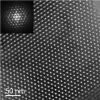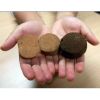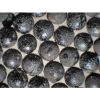Bio-Sourced Materials group

Ordered mesoporous carbon obtained by mechanosynthesis of tannin in the presence of water and triblock copolymer, used for electrochemical energy storage and hydrocarbon separation

Highly porous cellular materials derived from tannins. From left to right: Emulsion-templated monolith (support for enzymatic catalysis); Hierarchical double-porosity monolith derived from mechanically whipped aerated emulsion (carbon precursor for catalysis of oxygen reduction reaction); Rigid foam for thermal insulation

Compact monolayer of hollow carbon spheres (bioinspired metasurface for electromagnetic applications in the GHz range)
Last publications
- In situ immobilization of potentially toxic elements in soil using agricultural byproducts and wastes: A review
Erika Levei, Eniko Kovacs, Marin Senila, Vanessa Fierro, Oana Cadar
Journal of Environmental Management, 2025, 394, pp.127326. ⟨10.1016/j.jenvman.2025.127326⟩ - Sustainable valorization of spruce bark via hydrothermal carbonization for the production of furanic compounds
Taher Selmi, Eric Masson, Alain Celzard, Vanessa Fierro
Chemical Engineering Journal Advances, 2025, 24, pp.100881. ⟨10.1016/j.ceja.2025.100881⟩ - Boosting hydrogen storage and release in MOF-5 / graphite hybrids via in situ synthesis
Laura Jimenez Lopez, Rafael Morales-Ospino, Jimena Castro-Gutiérrez, Haroon Osman Sumbhaniya, Giuseppe Sdanghi, Sergio García Dalí, Alain Celzard, Vanessa Fierro
International Journal of Hydrogen Energy, 2025, 173, pp.151272. ⟨10.1016/j.ijhydene.2025.151272⟩
Presentation
The Bio-Sourced Materials group prepares, characterizes and models porous materials, particularly biosourced materials, mainly in the form of polymers and functional carbons. It is also interested in their applications in the fields of energy and the environment.
The team is located on the Campus des Métiers et des Qualifications Bois (Campus specialized in Wood Industries), on the premises of ENSTIB. It mainly converts bioresources: plant polyphenols, polysaccharides and simple sugars, even proteins, into high value-added materials.
It is interested both in basic sciences (surfaces and interfaces, green chemistry, physics, modelling) and in technological applications, among which:
- Heat management (insulation or heat transfer, solar energy storage)
- Storage, detection and separation of gases by adsorption (hydrogen, methane, co2)
- Electrochemical energy storage and conversion (mainly supercapacitors)
- Catalysis and electrocatalysis
- Liquid-phase or gas-phase adsorption for pollutant trapping
- Protection against electromagnetic waves.
In this highly competitive application context, the team does not refrain from also using some molecules or solids of non-renewable origin as additives or aids to synthesis (surfactants, cross-linking agents, 3D templates, porogens, etc.). Or even to develop purely synthetic materials, if they are more relevant, or for the purpose of material valorisation, until they can be replaced by resources of natural origin that are more respectful of the environment.
The materials are mainly foams, gels, powders, adsorbents and other types of porous monoliths, either cellular or reticulated, even 3D printed, as well as resins and membranes. The massive use of plant polyphenols, which are abundant but little valued, non-toxic and cheap, is one of the originalities of our approach. In particular, the team is a pioneer in the development of functional carbons with controlled porosity from tannins.
Since 2009, the team has also gradually built up an experimental platform for the synthesis and characterization of porous and/or biosourced materials covering 200 m2. This instrumental park is unique in Lorraine in terms of the number and complementary nature of its equipment and the analytical methods available (fin).
Research topics
Tannin-based and carbon-based materials and metamaterials for advanced applications
The team develops new porous and metamaterials for advanced and strategic applications for energy transition:
- adsorption and separation of gases: H2, CO2 and CH4
- insulators and superinsulators
- electrodes for electrochemical energy storage and conversion
- heat exchangers for the food industry
- materials for hosting phase-change fluids
- metamaterials for microwave and very high frequency applications
- catalysts for biorefinery
- materials for the production of fresh water by solar evaporation
The materials are mainly derived from bioresources, following an approach inspired by green chemistry. After essential characterization and optimization steps, they are integrated into real devices and the modelling of their structure and properties allows, after feedback on the synthesis, to improve their performance.
Projects:
- FEDER TALiSMAN (“Tannin and cArbon materiaLS and Metamaterials for Advanced applicatioNs”), 2017-2020
- FEDER TALiSMAN2, 2017-2021
- ADEME PANTHER (“Potential of tANnin aerogels for THERmal applications”), 2017-2019
- Grand’Est Region AEROBICS (“Superinsulating Biosourced Phenolic AERogels”) 2018-2019
- ANR ECONOMICS (“ECO-efficient and safe aNtifOuling surfaces for MIlk and egg proCessing industrieS”), 2017-2021
Theses:
- Doctoral contract 2016-2019, Zélie Marie
- PhD thesis 2018-2021, Caroline Françolle de Almeida
- Contract Researchers: 2017-2021 : Alexander Zharov, Karthik Raj, Sukanya Ramaraj, Raphael Canevesi, Daniel Torres-Gamarra, Sara Pérez-Rodriguez, Sébastien Schaefer
Articles:
- Hydrothermal treatment of tannin: a route to porous metal oxides and metal/carbon hybrid materials, Braghiroli et al., Inorganics 2017, 5, 7.
- Fire-resistant tannin-ethylene glycol gels working as rubber springs with tuneable elastic properties, Delgado-Sánchez et al., J. Mat. Chem. A 2017, 5, 14720.
- Easy preparation of tannin-based Ag catalysts for ethylene epoxidation, Schaefer et al., Chem. Select 2017, 2, 8509.
- Structure and electromagnetic properties of cellular glassy carbon monoliths with controlled cell size, Szczurek et al., Materials 2018, 11, 709.
- Floating hollow carbon spheres for improved solar evaporation, Celzard et al., Carbon 2019, 146, 232.
- An Enhanced Carbon Capture and Storage Process (e-CCS) Applied to Shallow Reservoirs using Nanofluids based on Nitrogen-rich Carbon Nanospheres, Rodriguez Acevedo et al., Materials 2019, 12, 2088.
- A new method for measuring the thermal conductivity of small insulating samples, Jannot et al., Rev. Sci. Instr. 2019, 90, 054901.
- Experimental investigation of the physical foaming of tannin-based thermoset foams, Marie et al., Ind. Crops Prod. 2019, 138, 111424.
- First approach for modelling the physical foaming of tannin-based thermoset foams, Marie et al., Int. J. Thermal Sci. 2020, 149, 106212.
Nanoporous carbons for hydrogen storage and compression
The team developed a proof of concept for a non-mechanical hydrogen compressor in collaboration with the LEMTA http://lemta.univ-lorraine.fr. When the tank is filled with hydrogen at 80 bar and 77K, its heating up to 315 K allows hydrogen flow rates of 30 NL/h at 700 bar to be achieved. The studied system is hybrid since it is made up of:
- a first stage of electrochemical compression, which compresses the hydrogen from 1 bar up to 40-80 bar
- a second stage of compression by adsorption-desorption which completes the compression up to 700 bar. The modified Dubinin-Astakhov model (MDA) is used to describe the adsorption of hydrogen on activated carbons depending on temperature and pressure conditions. The modeling results were validated by comparison with experimental data obtained from a 0.5 L prototype, designed and built for this work, and containing 0.135 kg of MSC-30 activated carbon (Kansai, Japan). (Find out more)
Currently, the team is working on the correlation between adsorbent textural parameters and MDA model variables as well as on the synthesis of different porous materials with high hydrogen adsorption capacity. Gas adsorption models are being developed in parallel to better characterise and optimise these nanoporous solids.
Thesis:
- International PhD thesis Lorraine Université d’Excellence (LUE) 2016-2019, Giuseppe Sdanghi
- CONACYT PhD thesis, 2018-2021, Pamela Ramirez-Vidal
Invited professor:
Professor@Lorraine Matthias Thommes, 2017-2020
Articles:
- Review of the current technologies and performances of hydrogen compression for stationary and automotive applications, Sdanghi et al., Renew. Sust. Ener. Rev. 2019, 102, 150.
- Modelling of a hydrogen thermally driven compressor based on cyclic adsorption-desorption on activated carbon, Sdanghi et al., Int. J. Hydrogen Ener. 2019, 44, 16811.
- Application of the modified Dubinin-Astakhov equation for a better understanding of high-pressure hydrogen storage on activated carbons, Sdanghi et al., Int. J. Hydrogen Ener. 2019.
- Enhanced resolution of ultra micropore size determination of biochars and activated carbons by dual gas analysis using N2 and CO2 with 2D-NLDFT adsorption models, Jagiello et al., Carbon 2019, 144, 206.
- Exploiting the adsorption of simple gases O2 and H2 with minimal quadrupole moments for the dual gas characterization of nanoporous carbons using 2D-NLDFT models, J. Jagiello et al., Carbon 2020, 160, 164.
Mesostructured carbon materials for electrochemical energy and separation
Mesostructuration of carbons is carried out by green chemistry, using a new environmentally friendly method based on water-assisted mechanosynthesis. Using only natural bark extracts, water and a surfactant, it allows ordered (with hexagonal symmetry) or disordered (wormlike pores) mesoporous carbons to be prepared in just one hour before pyrolysis. These solids are highly hydrophobic and have excellent application properties in the fields of energy and environmental, notably as supercapacitor electrodes, for CO2 retention from wet gaseous effluents, and for the separation of branched / linear hydrocarbons. Their different structures, depending on the synthesis conditions, having the same single mesopore size, are also tested for the calibration of reconstruction algorithms from electron tomography images and for modelling the properties of these nanoporous structures.
Thesis :
CONACYT-SENER, 2016-2020, Jimena Castro-Gutierrez
Articles:
- Synthesis of Perfectly Ordered Mesoporous Carbons by Liquid-assisted Mechanochemical Self-assembly of Tannin, Castro-Gutiérrez et al., Green Chem. 2018, 20, 5123.
- High-rate capability of supercapacitors based on tannin-derived ordered mesoporous carbons, Castro-Gutiérrez et al., ACS Sus. Chem. & Eng. 2019, 7, 17627.
Development of platinum-free cathodes for fuel cells
The first objective is to develop a platinum-free high-performance catalyst for the oxygen reduction reaction (ORR) based on porous carbonaceous materials doped with nitrogen and boron. The second objective is to optimize the formulation of platinum-free electrode inks in order to achieve reproducible Membrane Electrode Assemblies (MEAs), and then test them for electrochemical energy conversion in a Proton Exchange Membrane Fuel Cell (PEMFC). A spray-coating bench is used to deposit the electrode layers.
The team combines its expertise in carbonaceous material preparation and small-scale electrochemical testing with that of LEMTA http://lemta.univ-lorraine.fr/ in characterizing and testing MEA in instrumented fuel cells. This makes it possible to envisage the rapid development of alternatives to platinum-based electrodes, recognised as a major stake in reducing the cost of PEMFC technology.
Thesis:
International PhD thesis Lorraine Université d’Excellence (LUE), 2019-2023, Lara Bouleau
Articles:
- Electrochemical Reduction of Oxygen on Hydrophobic Ultramicroporous polyHIPEs Carbon, Seredych et al., ACS Catalysis 2016, 6, 5618.
- Combined Effect of Porosity and Surface Chemistry on the Electrochemical Reduction of Oxygen on Cellular Vitreous Carbon Foam Catalyst, Encalada et al., ACS Catalysis 2017, 7, 7466.
Affordable, high-performance "green" electrodes for Redox Flow batteries
The objective is to design, develop and validate a state-of-the-art Redox Flow battery, i.e., another electrochemical energy conversion system than a fuel cell, based on a new low-cost, water-soluble organic electrolyte, compatible with an optimised low-resistance membrane and fast kinetic electrodes for high energy density and long life. Battery engineering is focused on:
- performance optimisation through an advanced control strategy, reaching a LCOS (levelized cost of storage) < 0.10 € / kWh / cycle (end of project) and 0.05 € / kWh / cycle (by 2030)
- recycling, in order to minimise the environmental cost of battery installations. The prototype is tested and validated in the Siemens Gamesa https://www.siemensgamesa.com/en-int pilot plant in Spain. The team is working on the optimization of the fibrous carbon electrode
Project:
European project HIGREEW (“Affordable High-performance Green REdox floW batteries”), 2019-2021
Contract researcher:
Recruitment in progress, 2020-2021
Article:
Lignin-based carbon nanofibers as electrodes for vanadium redox couples electrochemistry, Vivo-Vilches et al., Nanomaterials 2019, 9, 106.
Other ongoing research projects
- Functional porous carbon materials derived from coal tar for energy and environmental applications (European Project RFCS (Research Fund for Coal and Steel) PROMOTEE ("Functional porous carbon materials derived from coal tar for energy and environmental applications"), 2016-2020)
- High temperature solar energy storage by peritectic compounds encapsulated in porous materials (ANR Project Pc2TES ("Peritectic compounds for thermal energy storage at high temperature"), 2016-2021
- Porous materials and functional carbons derived from hydrothermal carbonisation of lignocellulosic biomass (Carnot Project ICEEL-FEDER ECO-VALUE ("Bark valorisation by catalytic liquefaction"), 2019-2021
- Novel porous and functional carbon materials derived from hyper-crosslinked polymers (PICS (Programme for International Scientific Cooperation) Project PICASSO POPPY (Novel POrous carbon materials derived from hyPercrosslinked PolYmers), 2019-2021
Know-how
Elaboration
- Synthesis of biosourced resins as precursors of porous, powdery, fibrous or nanoparticulate materials
- Synthesis of porous functional carbons of any kind, graphitisable or not, from the above resins, from bioresources of vegetable or animal origin, from mineral coals, or from industrial waste
- Preparation of activated carbons for liquid- or gas-phase adsorption applications, from any precursor, by physical or chemical activation
- Synthesis of mesostructured carbonaceous materials, with hierarchical porosity, by green chemistry: soft-templating from phenolic resins of natural origin, without using formaldehyde or other molecules of petrochemical origin as cross-linking agent.
Characterization
- Porosity and specific surface area:
- Porosimetry and pycnometry: pore size distributions and pore volumes (mercury porosimetry to 3.7 nm), skeletal density (helium pycnometry), envelope density (powder pycnometry), fraction of open/closed pores (nitrogen pycnometry)
- Powder characterisation: tapped density and laser diffraction granulometry (10 nm - 3.5 mm)
- Transport properties in porous materials: water permeability and static resistivity to air flow
- Adsorption and co-adsorption of gases and vapours: N2, CO2, Kr, Ar, O2, H2, H2O, volatile organic compounds (VOCs), from secondary vacuum to 200 bars, from 25K to 750K, by manometry or gravimetry, in static or dynamic conditions, and chemisorption coupled with mass spectrometry
- Thermal properties:
- Conductivity, diffusivity, emissivity: Hot Disk method at controlled temperature (230K - 470K) and humidity, or under vacuum, laser flash (150K - 1370K), thermal camera
- Thermal stability and reactivity: thermogravimetry and DSC (150K - 1920K) coupled with mass spectrometry, absolute calorimetry of mixing or of adsorption (290K - 570K), isoperibolic calorimetry, contact (170K - 570K) or non-contact (290 - 350K) viscosimetry, measurement of the stability of foams, emulsions and suspensions (290 - 350K), solar simulator
- Electrical and electrochemical properties:
- DC electrical conductivity
- Quantities related to electrochemical energy: cyclic voltammetry, galvanostatic charge-discharge, electrochemical impedance spectrometry, rotating electrode for ORR (3 potentiostats - galvanostats)
- Mechanical properties:
-Thermomechanical analysis (130K - 1270K), dilatometry (130K - 1970K), universal (100 N and 2 kN) and impact tests, ultrano-indentation (diamond Berkovich, spherical or flat tips, or bio-indenter), measurement of elastic and damping properties of porous materials
- Surface properties:
- Surface energy: static and dynamic contact angles, force tensiometry
- Surface chemistry: pH-metric and potentiometric titration
- Surface charge and isoelectric point: zetametry for solid materials, membranes and particles
- Chemical, textural and structural analyses:
- Immediate and elemental analyses: moisture analysis and C, H, O, N, S analysis
- Spectroscopies: atomic absorption (Na, K, Mg, Ca, Al, Si, Fe, Ti, Mn, Cr, Ni, Cu, Zn, As, Cd, Pb, Ag), Raman (532, 638 nm and 785 nm) with imaging, FTIR (7000 - 550 cm-1) and imaging, UV-visible
- Microscopies: Optical, polarized light, atomic force
Modelling
- Modelling of adsorption isotherms of different gases for the textural characterisation of nanoporosity
- Modelling of mass and heat transfers in porous materials, finite element simulation
Technology transfer
- Industrial contracts for the substitution of certain toxic substances by natural products, for developing activated carbons and entering new markets, and for the characterisation of commercial products
- Maturation project 2019 - 2022 "MOST" (Carbon foams for thermal storage) supported by SATT Grand Est, for a major French building and public work company
- Pre-maturation project 2019 (4 months) "PressHyon" (Compression of hydrogen by adsorption on activated carbons) supported by LUE (project leader LEMTA)
Members
CNRS researchers
Professors, assistant professors
- Alain CELZARD
- Vincent NICOLAS
- Jean ZARAKET
Tenure tracks
- Sergei CHERNIAK
Technical and support staff
- Jimena CASTRO GUTIERREZ
- Philippe GADONNEIX
Post-doctoral researchers
- Tatiana LASTOVINA
- Rafael MORALES OSPINO
- Alexander ZHAROV
PhD students
- Aarti AARTI
- Monica AOUN
- Grishika ARORA
- Capucine BRISBOUT
- Asma FERCHICHI
- Sayan GOSWAMI
- Yasmine HAMMI
- Laura JIMENEZ LOPEZ
- Proscovia KYOKUNZIRE
- Priscila ORTEGA RIVERA
- Asmita ROHIT
- Malika SAAD SAOUD
- Supriya SAHA
- Haroon Osman SUMBHANIYA
- Aditya THAKUR
Publications
Contact
Head of the group
Vanessa FIERRO
vanessa.fierro@univ-lorraine.fr
+33 (0) 3 72 74 96 77
Epinal-ENSTIB
Institut Jean Lamour
ENSTIB
27 rue Philippe Séguin
BP 21042
88051 EPINAL Cedex 9
